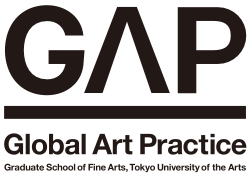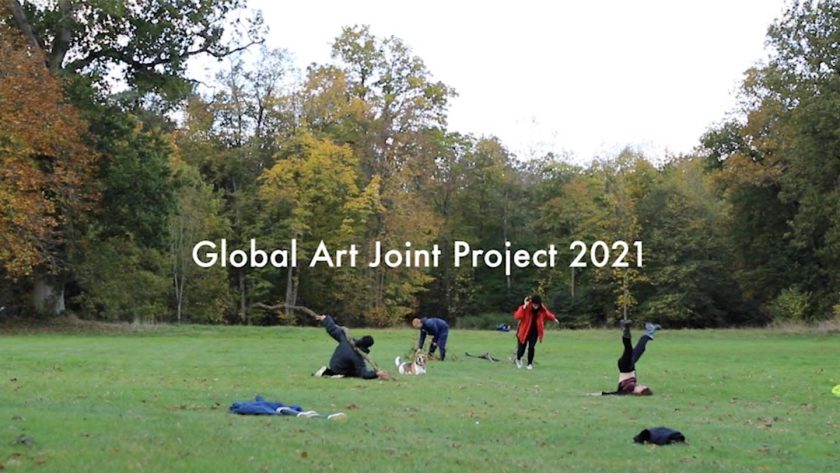International Joint Project, granted by the Japanese Ministry of Education, Culture, Sports, Science and Technology (MEXT) through its Program for Enforcing the Function of National Universities
Organized by Tokyo University of the Arts, Beaux-Arts de Paris, University of the Arts London Central Saint Martins
Planned by Tokyo University of the Arts, Beaux-Arts de Paris and University of the Arts London Central Saint Martins.
Global Art Joint Project 2021
文部科学省国立大学機能強化事業 〔国際共同プロジェクト〕
主催:東京藝術大学 × パリ国立高等美術学校 x ロンドン芸術大学セントラル・セント・マーチンズ校
企画:グローバルアート共同プロジェクト2021
Link: https://www.youtube.com/watch?v=H0wD6VVHjyg
Unit program is a joint educational program between 3 art universities: Beaux-Arts de Paris (BAP), University of the Arts London Central Saint Martins (CSM) and Tokyo University of the Arts (TUA).
The theme of this year was soil. Due to the COVID-19 pandemic, causing disruptions on traveling since the last academic year, classes and workshops were conducted online. Sessions have been divided into 5 parts, each part aimed to emphasize an expression through collaboration among the students from the 3 schools.
First Session (Introduction)
We started off with the guidance of the program, students’ introduction, Emmanuelle Huyhn’s body workshop, Yuko Mohri’s sound workshop, Yusaku Imamura and Heather Bartnett’s lectures and discussion on the theme of ‘Soil’.
Second Session (Workshop)
Art education can not be accomplished only by lectures. A direct face to face communication is necessary while we students engage in their practices.
The spread of COVID-19 in this academic year caused difficulties holding lectures, events, and exhibitions on a global scale. While the unit program also shared this crisis , we explored the possibilities of practical classes outdoors and activities without compromising on physical exchange and practice.
Each school went to the forest or river nearby to conduct outdoor classes. BAP invited Pascal Aumaître and Nuno Bizarro to carry out field work and a body movement workshop in the forest.
CSM invited guest lecturers, Masumi Saito and Heather Bartnett, to conduct field work using loupes and a body movement workshop in the forest.
TUA invited Akio Suzuki, Tetsuya Umeda, Yuko Amano, and Soichiro Mihara as guest lecturers to lead workshops around Tonegawa river to discover new materials and mediums and observe how installations could be created in nature, and fieldwork around Tonegawa to rediscover the river as a place for expression. The classes have allowed students to open up to new mediums and expressions.
Third Session (Online workshop)
In the third session, each school first shared their experience from the forest online, using Padlet and Zoom.
The aim of this session was to translate these experiences into a collaborative work. We used ‘Synchronic Theater’ as a place to collaborate tby synchronizing the 3 schools using the internet.
‘Synchronic Theater ‘ is a live-streaming system developed for this project to realize a collaborative production.
2 schools would separately shoot their students, while a synchronized image of the 2 schools would be projected on a large screen. In the actual space where the shooting took place, we only saw the students from one school, but on the projected image, the movements from the other school were superimposed.
As it was the first time students came across this medium, in this session, students began with technical tests and experiments to explore how to incorporate the experience gained through their practices and discussions into a collaborative expression.
Fourth session (Tutorial)
Students from 3 schools discussed the uses of ‘Synchronic Theater’ and how they would like to use the system as a medium for expression. Each student presented and exchanged their ideas along with the professors.
Fifth session (Final Presentation)
The final session was divided into 3 days.
The first day was a rehearsal, the second day was a collaboration and presentation between BAP and TUA, and the third day, between CSM and TUA. The last 2 days were the final presentations of the ‘Synchronic Theater’.
‘Synchronic Theater’ is a large-scale system that uses cameras, microphones, and lighting. Large sheets of paper were fixed on the background and floor so that students could also draw freely.
Unlike Zoom, which became widespread in the midst of COVID-19 and has limits on frame size and audio quality, ‘Synchronic Theater’ can give a greater sense of reality to the physical expressions.
While watching the projected images, students interacted with the movements performed in the other space. But there was also a curious sensation that the movements of the students began to parallel and synchronize.
Despite the short time, students were able to discover the characteristics of the medium, and create expressions that cannot be conducted in a traditional manner, such as approaching the camera, changing the size of the body and objects on the screen, and using sound. By working together over the five sessions, a common language was created among the students from distant countries, resulting in a work unique to this year’s unit program.
ユニットプログラムとは、パリ・ボザール校(BAP)、ロンドン芸術大学セントラル・セント・マーチンズ校(CSM)、そして東京藝術大学(TUA)の3校が共同で行う授業です。
令和3年度ユニットプログラムのテーマは「Soil(土)」。前年度に引き続き、COVID-19の影響により、諸外国を行き来することができなかったため、すべての講義やワークショップのプログラムをオンラインで開催しました。セッションは5つに分けられ、それぞれのセッションにおいて、学生たちの共同作業をとおした表現活動の実現を目指しました。
(1)第一セッション(導入)
このセッションでは、冒頭でプログラム全体のガイダンスを設けたほか、学生同士の自己紹介、エマニュエル・ユインによる身体のワークショップ、毛利悠子によるサウンドのワークショップ、今村有策とヘザー・バーネットによるプログラム・テーマ「Soil(土)」に関する講義とディスカッションを行いました。
(2)第二セッション(ワークショップ)
美術教育は座学のみでは十分に習得できず、人間同士が直接的に向き合いながら実践的に制作することが求められます。今年度はCOVID-19の拡大によって、学内での対面授業、あるいは展覧会を含む各種イベントが世界的な規模で困難に直面しました。ユニットプログラムもこの危機を共有しながらも、直接的な交流と実践とをあきらめることなく、野外での対面授業や表現活動の可能性を探ることにしました。
各大学がそれぞれ近隣にある森林や河川に出かけ、野外授業を実施。東京藝術大学は鈴木昭男、梅田哲也、天野祐子、三原聡一郎の4名のゲスト講師を迎えて、自然のなかで新たな素材やメディウムを開発するワークショップ、環境を利用したインスタレーション制作の見学ワークショップ、利根川をフィールドワークし河川敷を表現の場として再発見するワークショップなどを通じて、普段とは違うメディウムや表現方法にも自身を柔軟に開いていく実践を行いました。
また、コロナ禍において、入国が未だできていない中国在住の学生達も中国国内の森林に滞在し、自主的にプロジェクトを進めて発表しました。
(3)第三セッション(オンラインワークショップ)
第二セッションで各大学が得た経験を、ZoomやPadletといったアプリケーションを使用し、オンライン上でシェアしました。これらを3校による共同制作の表現に落とし込むのが、今後のセッションの目的です。
遠く離れた各大学をネットを介して画面上で同期させ、共同制作の場として「シンクロニック・シアター」を準備しました。
「シンクロニック・シアター」とは、この共同制作を軸とした授業をオンライン上で実現するために開発されたライブ映像システムです。2か所の空間からそれぞれ撮影を行い、同期させた映像を大画面でプロジェクションします。自分たちが表現行為をする空間には自分たちの現実しかありませんが、プロジェクションされた映像には、もう1か所で同時にされている表現行為が重ね合わされて投影されます。
学生にとっては初めての表現メディウムですので、本セッションでは、テクニカルなテストやリハーサルといったかたちで、これまでの実践やディスカッションで得られた経験をどのように表現に落とし込むか、学生たちの模索が始まりました。
(4)第四セッション(チュートリアル)
3校の学生が「シンクロニック・シアター」というメディウムを使ってどのような表現をしたいのか、各人が考えているアイデアをZoomを介して発表しあい、教員も交えてディスカッションを行いました。
(5)第五セッション(最終発表)
本セッションは3日にわたるもので、1日目がリハーサル、2日目がパリ・ボザール校(BAP)と東京藝術大学(TUA)との共同制作・本番、3日目がロンドン芸術大学セントラル・セント・マーチンズ校(CSM)と東京藝術大学(TUA)との共同制作・本番。いずれも「シンクロニック・シアター」での最終発表です。
「シンクロニック・シアター」はカメラとマイク、照明を使った大掛かりなシステムです。会場の背景と床に、ドローイングなどが自由にできるよう、大判の紙が貼られました。COVID-19のさなかに広まったZoomという、フレームサイズや音声のクオリティに限界のあるメディウムと違い、「シンクロニック・シアター」はフィジカルな表現にリアリティを持たせることができます。
投影された映像を見ながら、もう1か所で行われている表現行為にインタラクティブに呼応するだけでなく、同期していないはずの表現行為に類似性や同時性といったシンクロ感覚が生まれるという、不思議な認識感覚が表現を通じて得られました。
学生も、短い期間の中でメディウムの特性を発見し、カメラに近づいたり距離をとって画面上の身体やオブジェのサイズをかえたり、音響の使い方など、本来のシアターではあり得ない表現も生まれました。5つのセッションを全員で共有することで、遠く離れた学生あいだに共通の言語が生まれいき、今回のユニットプログラムならではの作品になりました。

